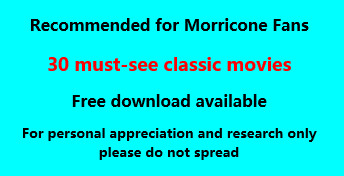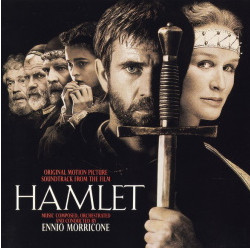THROWBACK THIRTY
Original Review by Jonathan Broxton
There have been literally dozens of versions of William Shakespeare’s Hamlet made for film and television over the years, ranging from Lawrence Olivier’s 1948 masterpiece, to Tony Richardson’s 1968 version based on his own London stage production, to Kenneth Branagh’s spectacularly lavish unabridged version released in 1995. In 1990 Italian director Franco Zeffirelli released his own version, which was made to appeal directly to Hollywood sensibilities through its casting of Mel Gibson in the title role. The story is, of course, a classic one, wherein the titular prince of Denmark plots revenge against his uncle Claudius, who murdered his brother the king – Hamlet’s father – with the help of Hamlet’s mother Gertrude. It’s a timeless story of violence, betrayal, retribution, and madness, and has a spectacular cast including Glenn Close, Alan Bates, Paul Scofield, Ian Holm, and Helena Bonham-Carter as the luckless Ophelia.
Franco Zeffirelli’s previous forays into Shakespeare, with The Taming of the Shrew in 1967 and Romeo and Juliet in 1968, resulted in spectacular scores by the great Nino Rota, but Zeffirelli needed to find a new musical voice for Hamlet as Rota had died in 1979. Perhaps inevitably, the composer chosen was the greatest Italian composer of his generation, Ennio Morricone, who was firmly a part of the film music mainstream at that point in his career, and was scoring mostly English language and Hollywood films. As far as I can tell this is the only Shakespeare adaptation Morricone ever scored, and it’s fascinating to hear his take on the bard.
By and large, Morricone approaches the story completely straightforwardly, concentrating on the drama and tragedy inherent in it all, without really offering any unusual takes or any of his occasionally idiosyncratic interpretations. It’s entirely orchestral, albeit with some occasional moments where a chorus is present, and it mostly focuses on the darkness of the story, which results in a score which can feel a little dour and depressing at times. It’s also not especially thematically strong, which is unusual for Morricone; there are recurring themes for Hamlet, for his doomed love Ophelia, and for the general concept of ‘madness,’ but none of them really assert themselves in the way that Morricone’s best themes do, instead seeming content to dwell in the murky gloom that characterizes most of the score.
Hamlet’s theme is a lament for strings, with an elegant but downcast melody that moves from violas to cellos, and is backed by a weary-sounding wash of violins. It captures the essence of the character perfectly – after all, he has just seen his father murdered by his uncle and mother, and is being counseled by his father’s ghost to commit murder himself, all while feigning madness and rejecting love – so from that point of view, it’s a success. Tonally, it reminds me a little of the elegant dirges Morricone wrote for films such as Casualties of War, and it has a little hint of Barber’s Adagio for Strings in the chord progressions. The second version later in the score switches the lead melodic performance from strings to oboe, and is in my opinion more appealing, despite the melancholy emotion of the piece overall. Later, its use in the pivotal “To Be or Not To Be” sequence underscores that most powerful of Shakespearean soliloquies with grace and sophistication.
Meanwhile, Ophelia’s theme offers a different melodic line, and slightly different instrumental colors, favoring soft brass, harps, and lightly darting woodwind textures to capture her initially more carefree, playful spirit. However, Morricone makes it clear that her story is one of tragedy too; when her caring advances towards Hamlet are rebuffed, when he tells her to ‘get thee to a nunnery,’ and when she eventually falls into a madness of her own following the death of her father Polonius at Hamlet’s hand, Morricone illustrates this with increasingly dark chord progressions, and moments featuring choral voices and, eventually, sadly lyrical woodwinds.
A lot of the rest of the score, when not featuring any of the two main themes prominently, tends to rely on elongated tones and shifting string chords, which create a mood and an atmosphere of appropriate tragedy and desolation, but don’t really last long in the memory. Anyone who has experienced any of Morricone’s more avant-garde works, especially the pieces he wrote with Gruppo di Improvvisazione Nuova Consonanza, will hear callbacks to that style. It’s all quite minimalist and atmospheric. Having said that, some cues are notable for one reason or another. “The King Is Dead” is a brutally heraldic call-and-response piece for somber, echoing brass, accompanied by imposing church organs and hammered pianos; it somehow manages to combine an array of regal fanfares for Claudius with tragic funereal tones lamenting Hamlet’s father, a combination of ideas which should not work in tandem but somehow do. Later, “The Ghost” is a sinister piece full of dissonant string and woodwind writing, coupled with eerie sound effects, both synth-based and vocal, perfectly capturing both the spectre’s terrifying presence, and the vengeful message it passes on to Hamlet.
The middle of the score contains a trio of interesting renaissance pastiches for the scenes involving the Player King, his acting troupe, and the way in which Hamlet uses their performance to reveal Claudius’s guilt. Morricone uses instrumentation typical of the period (pipes, fiddles, tambourines, lyres, and what sounds like a hurdy-gurdy) but arranges them in unusual ways – “The Play,” for example, is quite twisted, hinting at Hamlet’s duplicity and the none-too-subtle message intended for Claudius. Perhaps the most straightforward piece is “The Banquet,” a lively and playful dance with a jolly melodic core.
The final fifteen minutes or so of the score, from “Hamlet’s Madness” through to the conclusive “The Vaults,” sees Morricone leaning fully into the overwhelming tragedy of the piece, scoring Hamlet’s descent into madness and death with stark writing for strings, agitated but also somehow graceful, and made all the more edgy through the use of increasingly shrill woodwinds and metallic percussion. This ‘madness motif’ continues through most of “Simulated Madness” and “Second Madness,” and perhaps reaches its peak in “The Closet ,” which underscores the scene where Hamlet accidentally kills Polonius, and features Morricone writing at his most deathly, most anguished, and most dramatically profound. The forbidding twists and descending scales in Morricone’s writing here draws deeply from his Italian giallo background, to unnerving effect, while others may be reminded of the brooding orchestral tones Howard Shore brought to scores like The Silence of the Lambs.
Hamlet is a difficult score to summarize. It was written right in the middle of the period that contained so many of his most beloved works – The Mission, The Untouchables, Cinema Paradiso, Nostromo – but it really doesn’t sound like any of them. The melodic ideas are subtle and brooding, the emotions are much more skewed towards darkness and melancholy, and the whole thing has a profound seriousness to it, to the extent that many people will likely not feel the same sort of connection to it as they do to his other works of the period. Personally, it’s never been one of my Morricone favorites, but what I do like about it is how Morricone got deep into the underlying psychological issues that drive the story, and scored them rather than the more obvious elements that less sophisticated composers might focus on. Hamlet is a difficult score to love, and it’s certainly not one to play for fun, but it gives a strong insight into the intellectual side of Ennio Morricone, and for that it deserves a fair shot.
Buy the Hamlet soundtrack from the Movie Music UK Store
Track Listing:
- Hamlet (Version 1) (3:40)
- The King Is Dead (4:40)
- Ophelia (Version 1) (3:45)
- What A Piece Of Work Is Man (1:36)
- The Prayer (2:02)
- The Ghost (5:50)
- The Play (2:02)
- The Banquet (1:38)
- Dance For The Queen (2:12)
- Ophelia (Version 2) (3:00)
- Hamlet’s Madness (3:17)
- Hamlet (Version 2) (3:00)
- Simulated Madness (3:06)
- The Closet (3:24)
- Second Madness (1:54)
- To Be Or Not To Be (3:54)
- Solid Flesh (1:58)
- The Vaults (1:40)
Running Time: 52 minutes 38 seconds
Virgin Records 30939 (1990)
Music composed and conducted by Ennio Morricone. Orchestrations by Ennio Morricone. Recorded and mixed by Sergio Marcotulli and Fabio Venturi. Edited by Robin Clarke. Album produced by Ennio Morricone.












